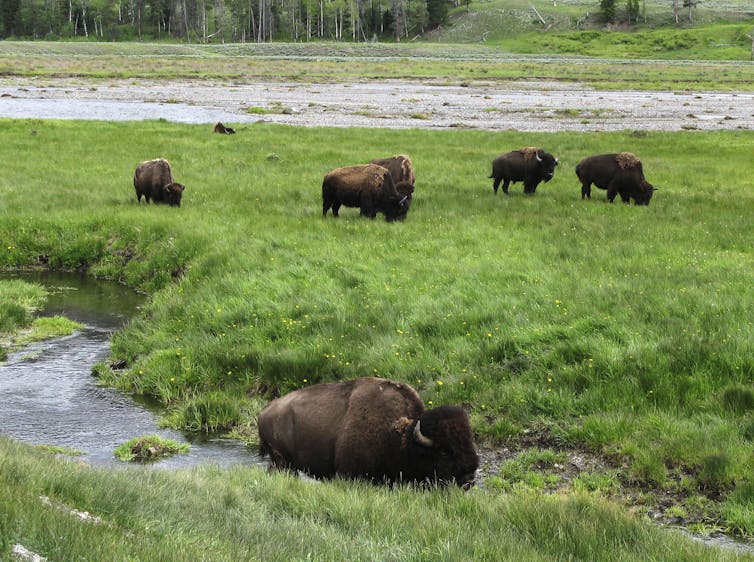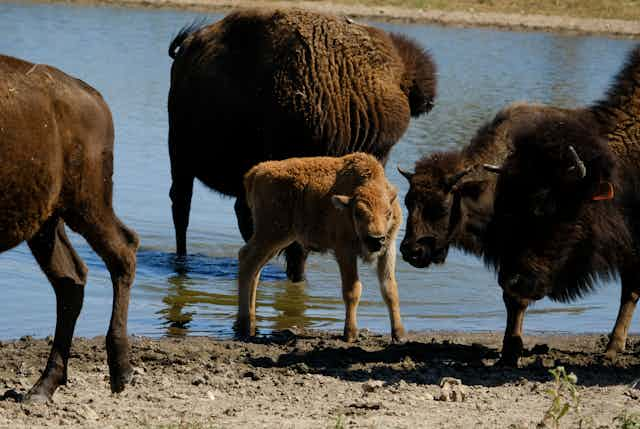The American bison, or American buffalo as they are commonly called, were once close to extinction. Their numbers dropped from 30-60 million to around 500 because of overhunting in the 19th century.
But they made an unlikely comeback and continue to captivate people. At Yellowstone National Park – home to the largest bison herd in the U.S., with almost 6,000 head of wild bison – they are a major attraction for visitors. In 2023 the park attracted more than 3 million people.
Conservationists and Indigenous people successfully saved the American bison from complete annihilation in the 20th century, increasing their numbers from less than 500 to more than 15,000 wild bison, which does not include the thousands of bison living on ranches. The U.S. even designated it as the “national mammal” in 2016.
Over thousands of years and across diverse landscapes, Indigenous peoples developed traditional ecological knowledge about the bison and their ecosystems. Meanwhile, they also developed religious customs and sacred places important to their relationship with bison.
As an Indigenous scholar and an enrolled member of the Blackfeet Tribe and Métis, I am interested in how Native Americans understand the natural world. I learned from my Blackfeet grandparents that bison emerged from the supernatural underwater realm and were given to humans by the Divine to use as food and as material. In return, humans are to respect and revere the bison.
Thousands of years of history
The modern-day American bison evolved around 10,000 years ago during the end of the Pleistocene Epoch from an ancient bison species. Over these several thousand years, according to environmental historian Dan Flores, Indigenous peoples and bison “co-evolved” – meaning they influenced the others’ actions and behaviors.
Indigenous peoples used bison meat and fat for food; hides for clothing, footwear and covering for their lodges; bones for tools; and other parts of the bison for rope, thread, glue or dyes. Along with the longtime use of bison for practical purposes, religious rituals and ceremonies also emerged.
Environmental historian Robert Morrissey writes in “People of the Ecotone” that Indigenous peoples in what is now Illinois ritualized running, a skill necessary for hunting bison. They developed coming-of-age ceremonies that tested the ability of young people to run long distances, as well as fast, to prepare for bison hunting.
Indigenous peoples in what is now Alberta, Canada, constructed shrines out of rocks to offer prayers to divine entities connected to bison hunting. They left offerings of tobacco or other items at these shrines during their seasonal hunts. Some of these rock shrines still exist and are viewed as sacred places.
Bison origins and sacred places
Indigenous people continued to remember and revere bison in rituals and ceremonies. Every tribe on the Great Plains has its own “deep individual connection to bison,” says Whisper Camel-Means, a Salish-Kootenai tribal member and wildlife biologist working at the tribe’s bison range. “We are all connected, but we all have a different relationship. Native people are not all the same.”
The Blackfeet believe that certain lakes and rivers are sacred areas because they are the home of the Suyiitapi, the supernatural underwater persons, and the place where bison emerged from underneath the water.
The Lakota, similar to the Blackfeet, consider bison sacred and a gift from the Divine. For the Lakota, however, bison did not come out of water, they came from inside the earth.
According to anthropologist Patricia Albers, the Lakota believe that both bison and humans emerged onto the Great Plains from what is now Wind Cave National Park in the Black Hills in South Dakota.
The Lakota believe this landscape to be their “most sacred and culturally significant” area because it is a place of genesis for humans and bison.
Gerard Baker, an elder from the Mandan-Hidatsa tribes, shared in a new PBS documentary film on the American bison, “When you look at a buffalo you just don’t see a big shaggy beast. You see life, you see existence, you see hope. Those are our relatives. They are a part of us.”
New efforts to revive the bison

This year, the U.S. federal government added US$25 million to “restore wild and healthy populations” of American bison on federal lands and $5 million toward accomplishing the same goal on tribal lands. And new legislation this fall seeks to further “develop the capacity of tribes” to manage bison and bison habitat.
“The restoration of buffalo back to our tribes and communities and reservations is part of our healing,” Jason Baldes, a member of the Eastern Shoshone from Wyoming, and the tribal buffalo coordinator for the National Wildlife Federation, told The New York Times, emphasizing why this kind of funding is necessary.
As more bison are returned to tribal communities, I believe, as my grandparents did, that bison are a gift from the Divine. It is a reminder also of how Native peoples relate to and understand the natural world and its deep religious meaning.

